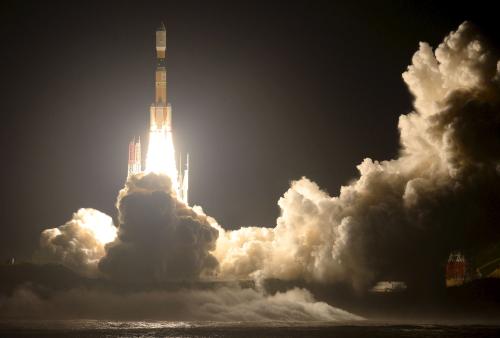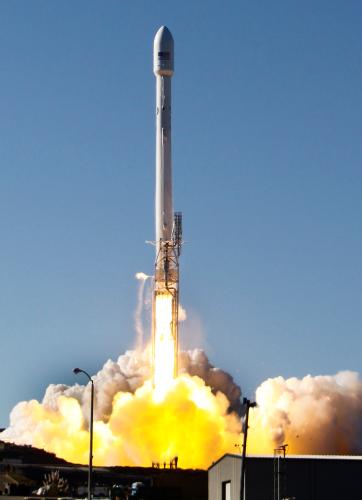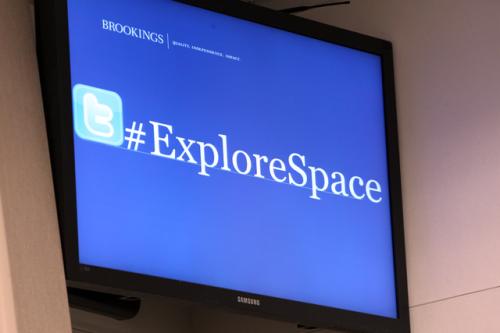Members of the international space community recently gathered in Guadalajara, Mexico for the 2016 International Astronautical Congress (IAC) to discuss current and emerging issues in the space sector. This year in particular, major launch providers took the opportunity to provide critical updates on their plans to develop the next wave of innovative launch vehicles.
Recent trends have pointed space launch in the direction of reusable launch vehicles, reaching the outer limits of what was once only possible in science fiction stories. We’ve seen increases in launch competition with “NewSpace” companies such as Blue Origin, SpaceX, and Virgin Galactic, while United Launch Alliance and Arianespace are continuing their efforts to create the next competitive vehicle.
In a much anticipated keynote presentation, Elon Musk, CEO of SpaceX, laid out his plans to build a sustainable city on Mars within the next forty to one hundred years. His argument for Mars follows many long and arduous debates within the international space community on how to break new grounds in space exploration in a post-Shuttle era. Priorities and opportunities vary widely in the commercial space sector, but competition is still very much a reality for the few commercial companies trying to enter a limited market in the future. In remarks given at IAC, George Whitesides, CEO of Virgin Galactic, expressed the importance of the planetary perspective and echoed the sentiments of Buckminster Fuller, where Earth is a moving spaceship that needs to be protected. When asked if there was any interest in Mars, Whitesides responded that while nothing is out of the question, focus now should be on increasing access to space, while decreasing the costs that are more practical.
When it comes down to the determining factor, it is not whether or not the technology can be built, but a matter of will it be built. Technological prowess does not override the many regulatory and budgetary hurdles that are very much a reality for such large-scale projects. SpaceX depends heavily on funding from NASA’s Commercial Crew Program. Current Space Act Agreements between the company and NASA provide SpaceX with the opportunity to deliver crew and cargo to the International Space Station. Even if the company begins crew missions to the ISS as early as 2018, this would not translate to providing transport to Mars.
Musk has yet to address the human aspect of human spaceflight, when he left out how his company plans to address safety issues for living on Mars. He briefly spoke about the risks in human spaceflight to Mars during the Q and A session and hesitated to go into further detail regarding how, once passengers arrive on the red planet, they plan to survive there. The risks automatically rise when there are humans involved. Whitesides exclaimed that risk is the primary differences between NewSpace and government. NewSpace companies are able to take a significantly greater amount of risk, while government agencies like NASA cannot. Especially with the large amount of funding NASA supports SpaceX with, their programs will need to adhere to the agency’s standards.
Elon Musk’s plans for an Interplanetary Transport System is exciting, but nonetheless is a challenging prospect with many questions left unanswered and many gaps to fill. He highlights four major challenges that SpaceX and other entities will face going to Mars:
- Full Reusability;
- Refilling in Orbit;
- Propellant production on Mars;
- Right propellant
Musk’s plan for colonizing Mars includes the development of an intricate and robust transport system with the ability to carry over 100 passengers on a vehicle that has forty-two engines. SpaceX plans to use a fully reusable vehicle that runs on cheaper fuel (but difficult to find). Current cost estimates to send a person to Mars runs approximately $10 billion per person, but the ultimate goal is to reduce that price to about $100,000 per seat. But even with this lower ticket price, a trip to Mars is still not feasible for the mass market they are trying to reach.
What everyone clearly agrees on is increasing access to space for anyone that is interested, while reducing the costs, and significantly cutting the gap between those who want to go and those who can afford to go. This, in itself, poses one of the greatest challenges. But many of these companies have revealed their plans in smaller, short-term proposals with a more general long-term vision in mind. Musk’s ambitious 100-year plan is perhaps an attempt to take the lead on discussions for the colonization of Mars.
We will be forever balancing our dreams and visions for exploration with the harsh reality of risk and budgetary constraints. And while Musk’s presentation was inspirational, there is an unfortunate reality that companies like SpaceX, among others, will need to face.





Commentary
The view from tomorrow: Challenges to regulating commercial space travel
September 30, 2016